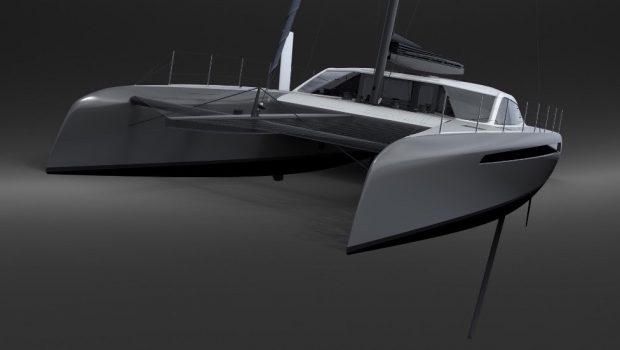Balancing Practicality and Performance
Published on March 15th, 2018
Performance is such a buzzword these days, overshadowing ease of use or even practicality. But boats still need to be sailed, and unless the plan is for a highly skilled (and compensated) crew to always be onboard, the sailability of the boat remains critical.
Cruising catamarans have been eyeing the foiling features of their racing brethren, and taking steps toward more performance through foil design. The team behind the soon-to-be launched Gunboat 68 detail the thought process they undertook to find their ultimate solution.
“When we started thinking about daggerboards, in addition to speed and comfortable motion, two important specifications we set were that they needed to interfere as little as possible with the interior, and when raised they needed to deliver a draft of 1.2m (4ft),” says Gunboat’s Benoit Lebizay.
“The latter limitation is to protect the saildrives, which have a draft of 1.1m (3ft 7in), in the event of a grounding. The daggerboard casings need to be able to withstand collision and the daggerboards themselves need to shear off without compromising the hull if grounded or in a collision at speed.”
When starting off down this road in mid-2016, the world had already gone foil-crazy: curved boards or straight, L- or J-profile, tips or no tips, and the full range of development and designs.
“We ran a whole range of board concepts,” says designer Vincent Lauriot-Prévost of VPLP. “It’s all about side force and vertical lift, and it’s driven by a brief that includes other practical parameters like reliability, interference with the interior, the simplicity of maneuvers and the versatility of cruising and racing versions.
“All the candidates we tested came from either ORMA trimarans, foiling and non-foiling IMOCA monohulls and the past three America’s Cup multihull editions. Ultimately it’s about finding the right compromise for this program.”
There were 14 iterations of board VPPs with different displacements, rig heights, symmetric and asymmetric boards – every variable there is. Also checked was true wind hull fly speeds to meet the safety targets: the performance-rigged Gunboat 68 shouldn’t fly a hull below 16 knots TWS, or over 20kts for the cruising version.
Without flying the platform, boards with foils or tips could not only generate lift, reducing wetted surface area and therefore drag, but could also help to improve comfort and stabilize the platform by preventing ‘heaving’ (sudden vertical movement when sailing through waves).
The curved boards created lift with the added bonus being how the boards and casings match the profile of the outside of the hull so they’re less intrusive below. VPLP ran a VPP study on a variety of curved boards, with and without tips, but they all showed that curved boards bring the center of lift inboard, actually reducing righting moment, which will make a hull fly earlier.
Safety is a key part of the Gunboat philosophy, and with the build complications of curved molds adding more complexity for very little gain, the vote was against curved boards.
“Then we looked at L-shaped boards with down tips to provide more lift,” says VPLP’s Xavier Guilbaud. “They were quite promising in terms of performance for downwind and reaching races like the Caribbean 600, but it was too radical for a round-the-cans regatta – and you end up with a draft of 2m (6ft 7in), which was a dealbreaker.”
And it wasn’t just a draft issue. The VPP showed L-tips provided more lift, but at normal boat speeds, below 20 knots, none generated enough lift to reduce wetted surface area and all of them increased drag significantly. Above 20 knots they would progressively generate lift up to around 30-40 percent of displacement, but it seemed difficult to justify adding L-tips as a standard option.
Curved and L-shaped boards were obviously not the right option although everyone liked the way they reduced heaving, which adds a lot of comfort to the ride.
“The breakthrough came when we suggested using straight boards, but canting them inboard,” says Xavier. “We ran another VPP and confirmed we were onto something. This option delivered lift and, because of the cant, reduced heaving.
“We increased the length by 850mm and saw significant performance gains across 90 percent of the wind angles. Upwind, asymmetric boards always performed better above 15 knots TWS, but only if your crew switches boards on every tack. This revealed another advantage of symmetric boards: you can leave them both down, which is great for cruising.
Simple canted straight boards proved to be the best option with three configurations available: short symmetrical boards for cruising at one end, high aspect ratio long asymmetrical boards for pure racing at the other, and in the middle the long symmetrical boards for the owner wanting to run both cruising and racing programs.
“In the future we might see concepts like straight boards with horizontal tips or heave-damping Z-foils for performance and comfort at sea,” adds Lauriot-Prévost, “but for Gunboat 68-01 none of these options fit the original brief because it is impossible to fit the boards from deck or satisfy the draft limit. VPLP’s toolbox is full of different concepts – it is all about where we put the cursor between practicality and performance.”










 We’ll keep your information safe.
We’ll keep your information safe.